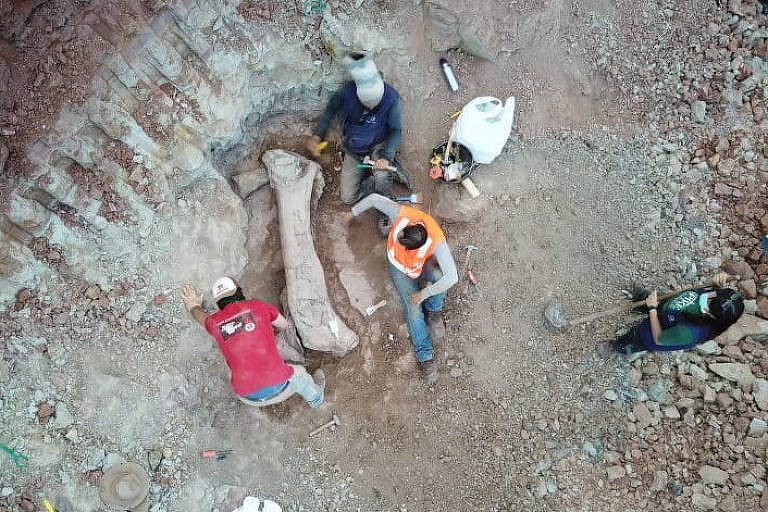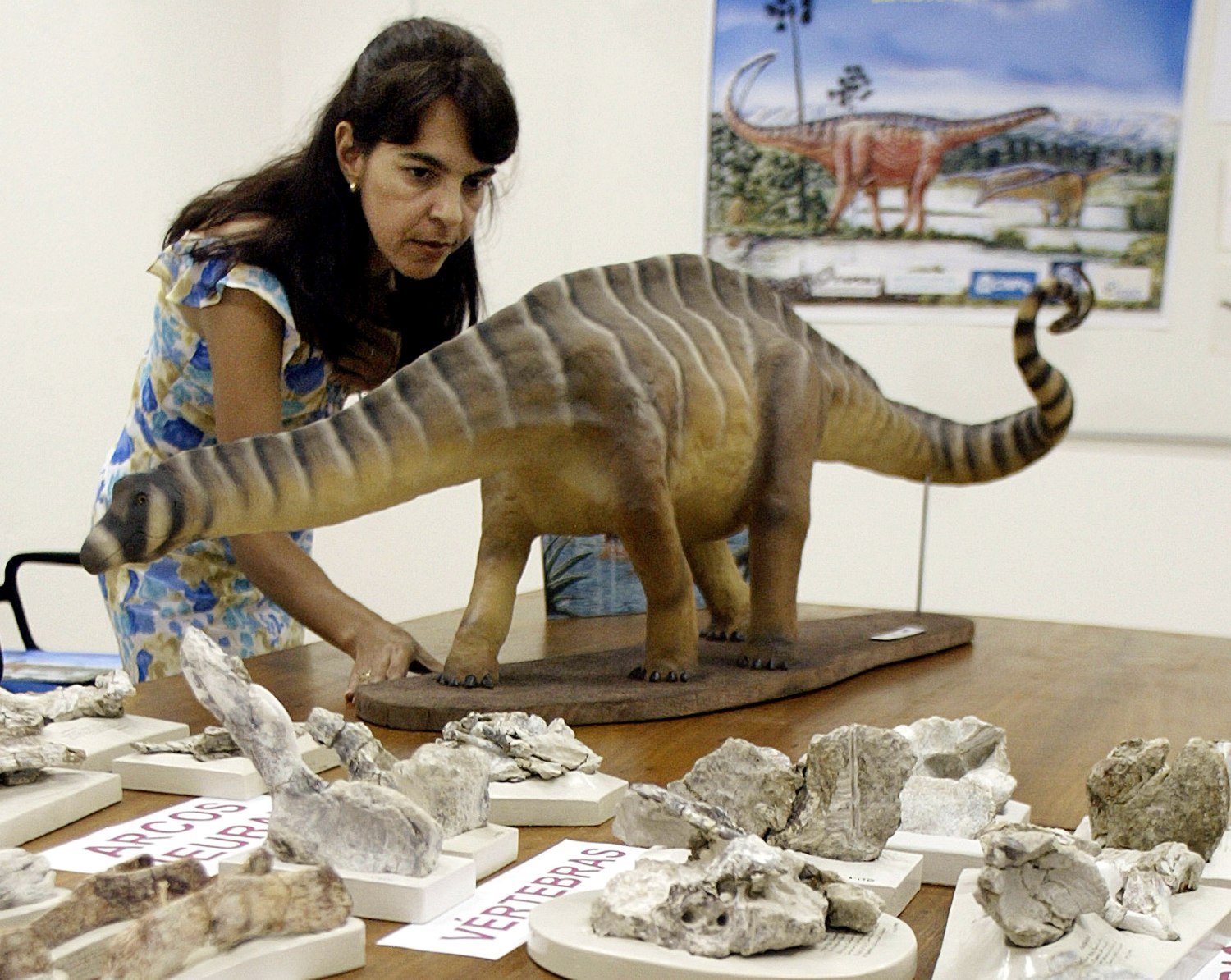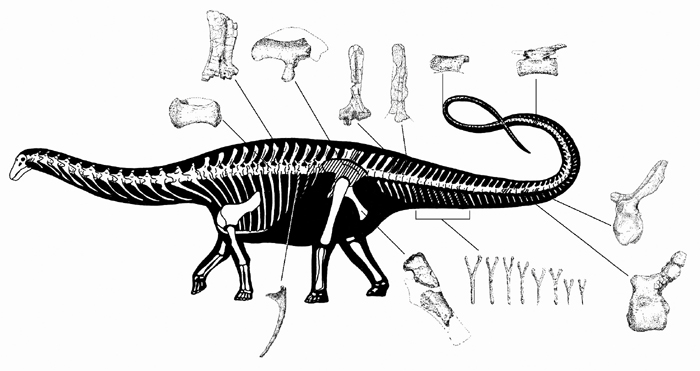
Excavation for the construction of a railroad in the municipality of Davinópolis (metropolitan region of Imperatriz), in Maranhão, revealed a fossil of a giant dinosaur that is still unknown to the scientific community.
Among the material found was a femur measuring more than 1.5 meters in length, other long bones, such as a possible tibia, foot and hand, numerous ribs and vertebrae.

The fossil was the first known dinosaur for the region and possibly an important record for the evolutionary history of the group of sauropods, which inhabited what is now Brazil about 130 million years ago, in the period known as the Early Cretaceous.

Although it is not yet possible to know the species of the new dino, due to the size of the bones and its type, they are most likely from a titanosaurus, a group of long -necked dinosaurs that appeared in the late Jurassic, nearly 163 million years ago. They lived until the end of the Cretaceous, when they disappeared along with other non-avian dinosaurs (66 million years ago).

“It is already known in the literature of some records further north of the state, but it is the first large vertebrate fossil for the locality, which generally finds fossils of fish and plants”, explains Elver Luiz Mayer, paleontologist and professor from Unifesspa (Federal University of the South and Southeast of Pará), responsible for the preparation and study of the dino.

The estimated size of the dinosaur is up to 18 meters long, almost twice as long as another long-necked one also found in the state of Maranhão, the Amazonsaurus Maranhensis, one of the smallest titanosaurus described to date.
But, different from Amazonsaurus, the new specimen is near the region known as the Tocantins of the Itapecuru Formation, while the former is found further north of the state.
Brazil’s titanosaurus records are best described for the regions where the Sanfranciscana, Paraná and Bauru rags are found, in the states of Minas Gerais, São Paulo and Paraná. One of the best preserved specimens, including a skull with a full jaw, is the Tapuiasaurus macedoi, located on the rocks near the municipality of Coração de Jesus, north of MG. This is the first Brazilian sauropod dinosaur to have also been preserved.

The Davinópolis fossil does not have any isolated skull or tooth material, somehow it is found today. “Although the collection work is tedious, there are signs that there is more fossil material in the area because the slope is relatively wide, and there is a rocky stratum about ten meters above,” Mayer explains.
Initially, employees of the Brado company, which was responsible for earthworks in the region and who found the fossil, believed to be the bones of giant sloths, animals that lived about 11,000 years ago and were killed in last glacial period.

Consequently, a team of archaeologists was called in to accompany the work. They contacted Mayer, whose specialty was Quaternary mammals (period known in the last Ice Age). “But when we got there, we saw that it was something bigger and that it lived longer because of the depth where the bones were buried,” he said.

After obtaining permits from the National Mining Agency to remove the material for didactic purposes, with no interest in exploration — the fossils are the property of the Union and therefore cannot be explored or commercialized—, the material was brought in the laboratory of the Study Group on Paleontology (GePaleo) from Unifesspa, in São Félix do Xingu. There Mayer and his team fix him up.
Given the approximate age of the rocks from which the fossil was removed, the formation of Itapecuru, it is possible that the new dino is at an age close to the tapuia, as the neck of northern Minas is happily called, explains Bruno Navarro, paleontologist at the Zoology Museum from USP, who defended his master’s thesis on the institution about the evolution of the titanosaurus.
“It’s rare to find a large fossil in a good state of preservation. In general, in the titanosaurus group, it’s more common to find vertebrae that are pronounced or not. It’s hard to find a preserved long bone. The search is very important because it opens up a new frontier to understand the fauna of the region, which until then was known for some fossils of plants, insects and fish ”, explained Navarro.

Moreover, it is known that the titanosaurus appeared in the late Jurassic, but with records in South America mainly from the Lower Cretaceous onwards, with some older findings, the new dino may bring new information about the history of evolution. of the group.
“Whether he may be related to other Brazilian titanosaurs, such as Tapuia himself, is unknown. It needs to be studied, but it may bring relevant information about the most primitive nature of the group. it’s in the region where Brazil is today, ”he said.

The paleontological community can still look at the description of the new species, but it should still take at least five years.
“To prepare all the material, considering the impact of the pandemic on students’ access to laboratories, it will still take almost two years. And in parallel, we will study the material in other known sauropods, to try to show this fossil to the community as soon as possible, ”Mayer added.
